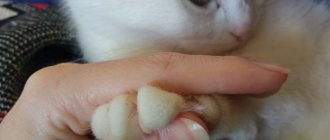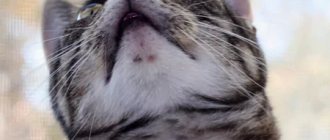The cat is an amazingly beautiful, graceful creature that is very popular among animal lovers. The variety of breeds allows you to choose a purr to suit your taste and color - from a fluffy Persian beauty to a peculiar hairless sphinx with a cosmic look. But some people, fed up with traditional “domestic” cats, prefer their wild counterparts with the unusual color and proud gait of a tiger, lynx or leopard.
We present to you the top 5 most popular wild cats, which often become pets.
Savannah is a hunter with a temperament
This exotic beauty is the result of crossing a domestic purr and a wild serval. The breed owes its appearance to a breeder named Judy Frank, who dreamed of breeding an unusual cat with a wild temperament. She gave rise to breeding work, as a result of which it was possible to obtain a graceful beauty with an amazing spotted color.
Having heard that the Savannah is a hybrid of a wild and domestic cat, many fear that this is an aggressive animal. In fact, this is not true. The exotic purr is affectionate and devoted to one person, and usually shows favor towards other family members. However, this does not mean that the cat will sit in the corner. Savannah is a four-legged hunter who is distinguished by mobility, activity and playfulness.
Can a stray, feral cat become a pet?
Contents hide
Can a stray, feral cat become a pet?
Probably each of us (some already in childhood, when they brought kittens home from the street) tried to answer this question. As experts say, it is necessary to immediately distinguish between concepts: there are absolutely wild cats, and there are feral, stray cats that have had or have “experience” of contact with humans. It doesn't matter whether it's positive or negative. There is an opinion that any cat can be returned to home life - just show love and affection, plus, of course, constant and stable nutrition. But is this really the case?
A lot of time and patience. It is, of course, possible to return a feral cat to domestic life, although it will take a lot of sweat, effort and labor, but no one will give a 100% guarantee of the result. The main thing is no haste. The first step is to gain the animal's trust. Then just be patient and wait to see what happens. Accordingly, the younger the animal, the higher the chances of success. By adopting and warming up a street kitten, you get a chance to get a good and affectionate pet. As for adult cats, it depends on your luck.
It’s easier with kittens. Agree that it is much easier to bring an outdoor kitten (6 to 12 weeks old) into your home than an adult animal. The problem is that you won't know his exact age. Street kittens always feel smaller than their “domestic” counterparts. Having caught the kitten you like or adopted it, give it some time to adapt to the new environment, and then be sure to visit the veterinarian. Your kitten may well already be a carrier of many dangerous diseases that can be transmitted both to other pets and to people. Go to the vet immediately (or have a professional make a house call) if the kitten you've adopted seems sick.
It will be very difficult at first. The best way to quickly adapt a kitten to the house is to give it freedom of movement (movement). The kitten must literally absorb the unfamiliar smells that wash over it, must go around every corner of the new house, and see everything with its own eyes. Reinforce your good intentions with various goodies - let the kitten feel completely safe with you, that he is taken care of, and is given plenty of water and drink. After some time, the kitten will get used to the situation and get to know people and other pets.
Choose interactive games. Let the first games be easy. The simplest and most effective game, based on the kitten’s hunting instincts, is “try and catch.” A regular candy wrapper tied to a string will do!
When can you pet a kitten? As soon as you feel that he has begun to get used to it. Start with your favorite places - stroke the back of the head, behind the ears. Give me a treat. Accustom your kitten to affection gradually, do not shower your love on him right away!
You can count on absolute success if your kitten is descended from feral domestic cats. However, some people are trying to tame obviously wild kittens. Neither they nor their parents had ever had the experience of close communication with a person and were not socialized.
Socialization comes first. Even a feral cat will eventually “remember” what it’s like to be a domestic cat. As we noted at the beginning of the article, the chances of success remain the same when you feed even an adult animal. Of course, at first it will be extremely timid, afraid and avoid direct contact. But there are still chances! It all depends on how long the animal was left to its own devices and whether it had any experience of contact with a person “in a past life.”
Stray and wild cat: what is the difference? As we said, a stray, street cat has not lost contact with people, it may have previously been a domestic cat, perhaps it still somehow depends on people, for example, it feeds near homes or enterprises, offices.
The wild cat has never maintained contact with people. She is absolutely self-sufficient and does not depend on people in any way, earning her own food. The chances of success with such cats are minimal - they do not understand what home warmth and comfort is, or what it is like to take a nap on the lap of their owner. Moreover, they don’t need all this - they have their own way of life.
But on the contrary, there are chances to return a stray cat to normal life. It will take a lot of time. But they know very well what advantages domestic cats enjoy in life. Please be patient and attentive!
But be prepared for a pessimistic scenario, both with a wild and feral cat. Perhaps both will finally choose a street lifestyle. This will make them more comfortable. But they will be friends with you, gratefully accepting the fact that you constantly feed them.
Original post: Can Feral Cats Really Be Tamed? Source and photo:
Lynx (caracal) – a pet for those with character
Most of us are accustomed to thinking of the lynx as a wild animal. However, despite its temperament, this large cat can easily live at home. True, it will not be possible to tame an adult, so the best option is a small kitten, which will become a tame pet thanks to the patience and affection of the owner.
Most often, the caracal is chosen for the home - a spectacular beauty native to Africa with black ears and reddish-brown fur. It has a strong build, long legs and green eyes. By its nature, the caracal can hardly be called a domestic cat, since it is very active, loves solitude and, of course, is a real predator at heart.
It is quite difficult to purchase such an animal, since this type of lynx is sold exclusively in nurseries. There is one more point: caracals value a strong character, so an owner without an inner core will not suit him.
How did the forest cat appear?
Researchers from the United States have revealed that the wild forest cat is the great-great-grandfather of modern cats, which were domesticated more than 10,000 years ago. This happened in the Middle East, where there were grain storage facilities, which created nests for rodents near them. Following the rodents, hunters appeared - cats.
Wild cats gradually got used to human habitation and became domesticated, but some animals remained living in the wild, although the population was sharply declining.
Pixiebob - short-tailed cutie
The cute pixie-bob is somewhat reminiscent of a lynx, and this is not surprising, because breeders sought to get exactly this type of wild cat. True, unlike the lynx, the pixie-bob does not have tassels on its ears. But these animals have an unusually cute face and a very short tail, which can be safely called their distinctive feature. Another interesting nuance: the pixie-bob often has polydactyly (extra number of toes).
Is it legal to keep wild animals?
In Russia, an unambiguous law has not yet been adopted, according to which it would be prohibited to keep wild animals in apartments.
Initially, a list of fauna representatives was formed that cannot be kept in apartments, private houses and illegally organized petting zoos. The ban, however, did not apply to those animals that were purchased before January 1, 2021 - they are allowed to be left with their owners. In addition, this list included those animals whose natural habitat differs significantly from a possible artificial one, and therefore relocation to “urban” conditions will lead to numerous illnesses or even death. In general, we were talking about some species of snakes and lizards, crocodiles, turtles, arachnids and amphibians. The townspeople lost the opportunity to have a bear, a tiger, a wolf, a lion and a hyena, some ungulates and birds. The document even included cetaceans and fish such as rays, perches, eels and sharks. Animals were selected according to two criteria: danger to people and exposure to the adverse influence of the artificial environment. This ban did not apply to zoos, circuses, dolphinariums and other legally operating organizations.
However, in July 2021 it became known that some exceptions had been introduced into the law. For example, it is legal to place an injured animal in a non-residential premises until it is transferred to the supervision of specialists. Employees of zoos, circuses and dolphinariums also have the opportunity to temporarily house animals while they are being treated or while they are in a condition that requires additional care.
It turns out that the law on the responsible treatment of animals came into force on January 1, 2021, but regarding the keeping of wild animals in an apartment, it still requires improvements, which will come into force on January 1, 2021.
Housey (Chausie) - an energetic predator
This breed appeared at the end of the last century by crossing an Abyssinian cat with a wild jungle cat. Despite the fact that the Chausie family had far from the most affectionate ancestors, representatives of this breed can be called obedient. They are incredibly smart, active and in excellent health. They can often be seen in motion, are full of energy and love interactive games.
However, a predator is a predator, so the Housie does not get along very well with either children or pets. But a cat of this breed will simply adore the owner, and this is not surprising, because the pet cannot stand loneliness and really appreciates attention!
Features of feeding
Small kittens are fed up to 6 times a day. The older the animal gets, the less frequent feeding becomes.
You should not introduce chicken as the first meat dish, as its poor quality may harm the kitten’s health. It is better to use a quality product.
In total, the diet should contain not only meat dishes, but also vegetable, fermented milk, and cereals.
The price for a jungle cat can reach $5,000, and even starts at $2,000.
Read also (updated 12/03/2020)
Below we have prepared for you links to publications that have recently become particularly popular among our readers:
- how to feed a newborn kitten without a cat;
- why does a cat always want to eat?
- Malamute dog;
- bird robin;
- what a poisonous viper looks like and where it lives.
Little cute animals
If you want less hassle, keep the animal in a cage. He doesn’t need to be toilet trained, walked, or cleaned up all over the apartment. It is enough to choose a suitable house, pour sawdust, feed the animal and keep its home clean. Let us describe in more detail the animals kept in cages.
Hamsters are funny rodents. They love to run in a wheel, sleep curled up in a ball and eat, funny stuffing their cheeks with food. There are many varieties of these rodents, differing in color and size. The most popular are Angoras with long hair and Syrians, which can be golden, black, gray and white.
They put a house, a food bowl, a drinking bowl and a tray in it. They also install a small container with fine sand, with which the animals clean their coats. It’s not difficult to care for your pet’s house: you need to throw out leftover food, refresh the water and change the sawdust every 3-4 days.
Meerkat
Charming miniature animals from the mongoose family are incredibly charismatic and energetic. In order to keep a meerkat at home, you will not need a special enclosure or cage. The baby will calmly move around the house and sleep wherever necessary.
Meerkats can easily be trained to use a litter box, just like an ordinary cat. The animals feed on mushrooms, nuts, lean meat, milk and sour cream.
Meerkats are sociable animals. They can easily make friends with dogs and cats. But they get along best with each other, as they live in packs. Therefore, try to get two touching creatures at once, so that they definitely don’t get bored alone.
Bombay
Remember the beautiful panther from the cartoon Mowgli? Would you like to have one like this at home? Of course, a large predatory cat is not very suitable for keeping at home, but a miniature Bombay is just right! Mickey Harner worked on creating the breed for almost 20 years, but the result was worth it. The Bombay mini panther looks amazing. The animal has blue-black shiny fur and bright orange eyes. The movements are smooth and graceful, like a real wild animal.
Ocicat breed
Not all rare breeds of wild cats can boast of true predatory ancestors. For example, representatives of the Ocicat breed are incredibly similar to wild ocelots. But they do not have the genes of these predators. The breed was bred entirely on the basis of pets. In the long list of progenitors you can find the Siamese, Abyssinian, and American shorthair cat.
Ocicats have a light brownish-gray coat with elongated dark spots. The base of the tail, neck and head are decorated with rings and stripes.











